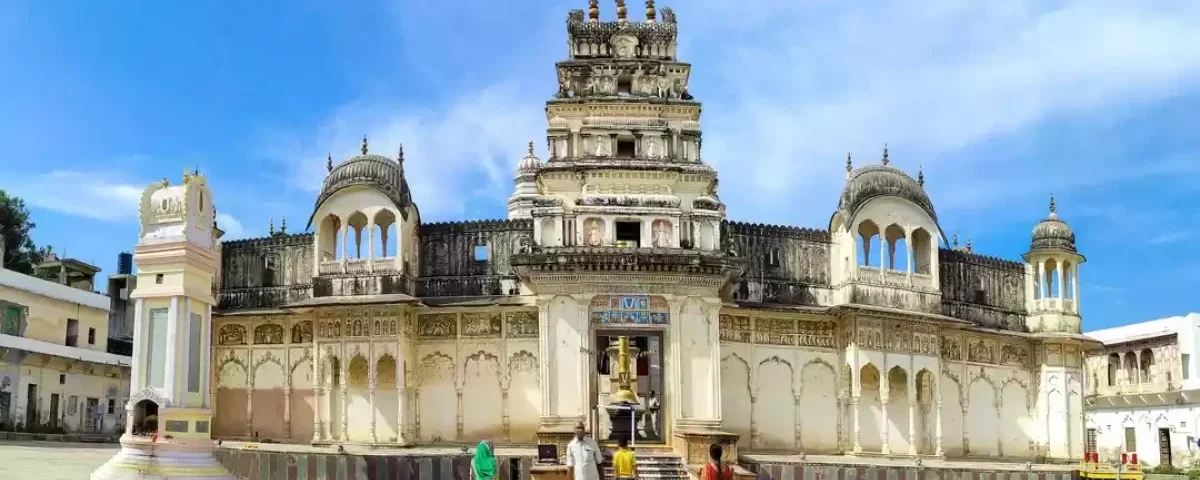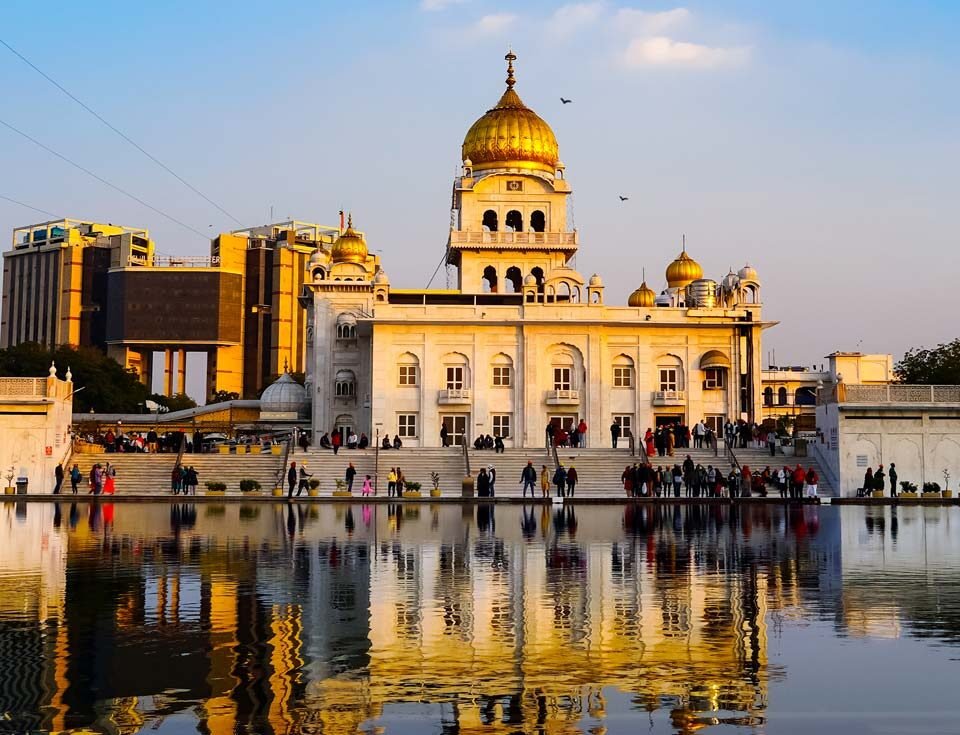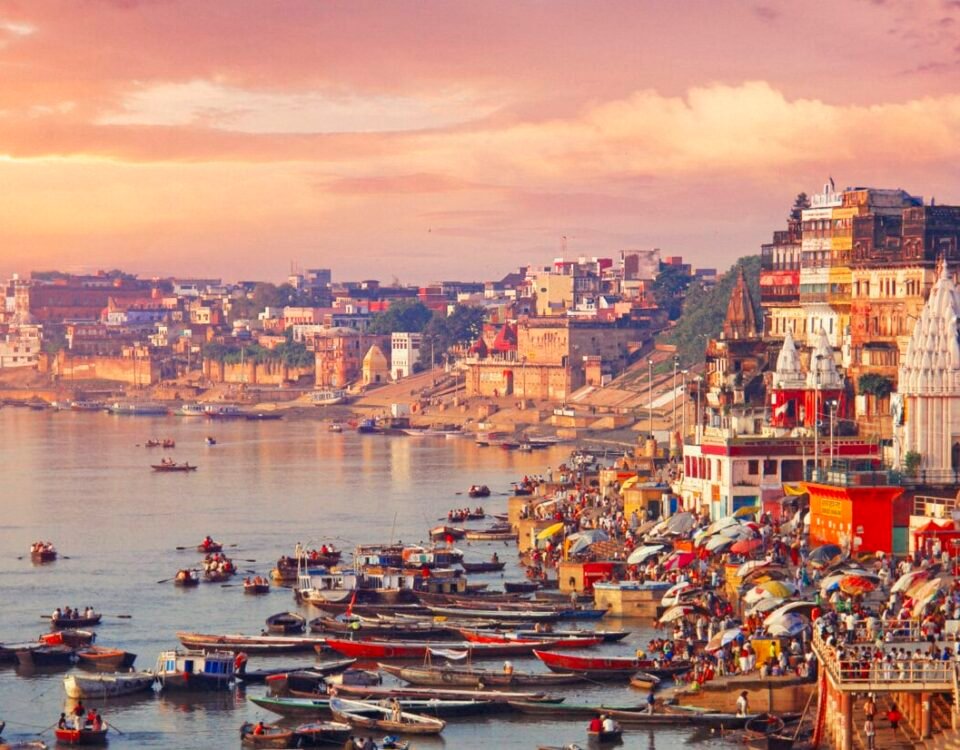Brahma Temple Pushkar Guide: Timings, Aarti & History of the Sacred Mandir in India

Best Places to Visit in India During July: Top Destinations to Travel This Monsoon
July 4, 2025
Top Hill Stations in Rajasthan to Beat the Desert Heat
July 4, 2025Introduction to the Sacred City of Pushkar
Nestled amidst the Aravalli hills of Rajasthan, Pushkar is one of India’s oldest and most sacred towns. Known for its spiritual aura, shimmering lake, and centuries-old temples, Pushkar is often called Tirtha-Raj—the king of pilgrimage sites. Pilgrims and travelers alike flock to this serene town to seek blessings, witness timeless rituals, and immerse themselves in an atmosphere of divine calm.
In Hindu mythology, Pushkar holds a special place as the land created by Lord Brahma. Legend has it that when a lotus flower fell from Brahma’s hand, it landed in Pushkar, giving rise to the holy Pushkar Lake. This divine event marked the beginning of the town’s spiritual legacy, making it one of the few places where Lord Brahma is actively worshipped.
Among the many sacred sites in the town, the Pushkar Ji Temple—a reverential reference to the main Brahma Temple—stands as the spiritual heart of the region. It forms a vital part of India’s holy pilgrimage circuit, drawing in devotees, mystics, and curious travelers from across the world. Visiting Pushkar is not just about seeing a town—it’s about experiencing a divine chapter of India’s spiritual heritage.
The Significance of Brahma Temple in Pushkar
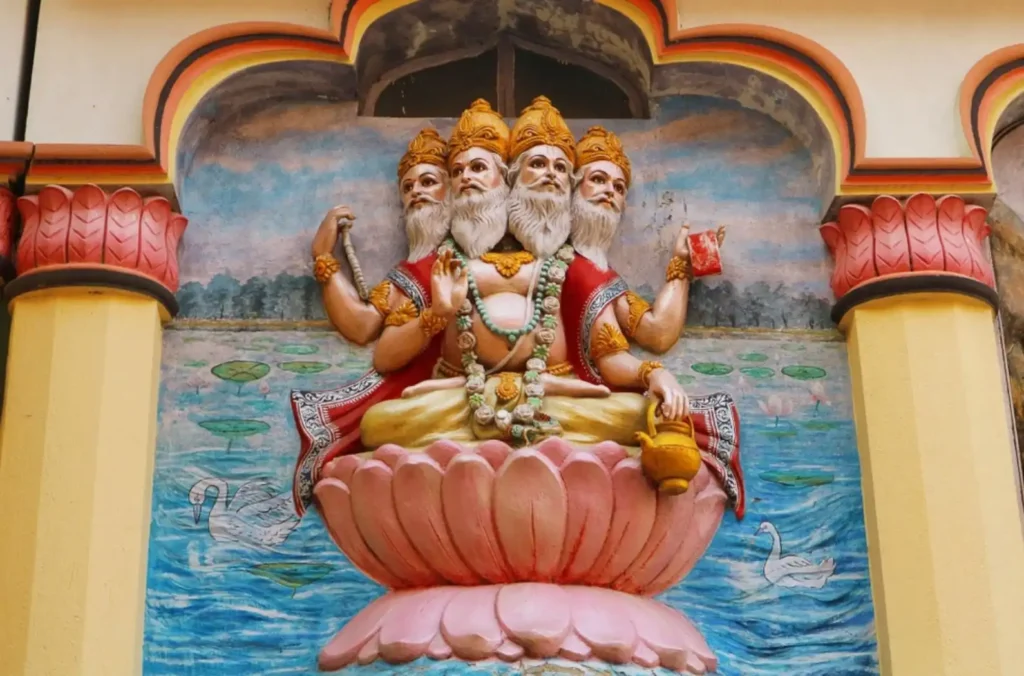
The Brahma Temple Pushkar is not just a sacred shrine—it is a rare spiritual marvel. Dedicated to Lord Brahma, the creator of the universe, this temple holds immense mythological and religious significance. While countless temples across India honor deities like Shiva and Vishnu, Brahma Mandir in India are incredibly scarce, making the Pushkar temple a unique destination in the Hindu pilgrimage landscape.
🕉️ Mythological Background of Lord Brahma
According to ancient Hindu texts:
- Lord Brahma is considered the creator in the holy trinity (Trimurti), alongside Vishnu (the preserver) and Shiva (the destroyer).
- Legend says Brahma descended to Earth to perform a yajna (fire ritual) to maintain the balance of the universe.
- When his consort Saraswati could not arrive on time, Brahma married a local maiden, Gayatri, to complete the ritual—an act that led Saraswati to curse him.
- Her curse decreed that Brahma would not be widely worshipped, which is why Brahma Mandir Pushkar remains one of the only temples dedicated to him.
🌍 Unique Status of Brahma Mandir in India
What makes this temple truly one-of-a-kind:
- It is one of the very few existing Brahma temples in the world.
- It’s the most prominent Brahma temple in India, attracting devotees, saints, and spiritual seekers.
- The temple’s sanctity is enhanced by its proximity to the sacred Pushkar Lake, believed to have formed from a lotus dropped by Brahma himself.
🔱 Why This Temple Is One of Its Kind
- The Brahma Temple Pushkar showcases a rare spiritual devotion in a religion that usually overlooks Brahma in active worship.
- Its rich red spire, silver coins, and idol of Brahma with four faces are symbolic of the cardinal directions and creation.
- The temple is maintained by ascetic priests and has stood as a pilgrimage center for centuries, especially during the annual Kartik Purnima festival when thousands gather for holy dips and rituals.
In essence, the Brahma Temple in India, specifically in Pushkar, is not just a place of worship—it is a living legend, a mythological wonder, and a cornerstone of India’s sacred geography.
Historical Background and Architecture
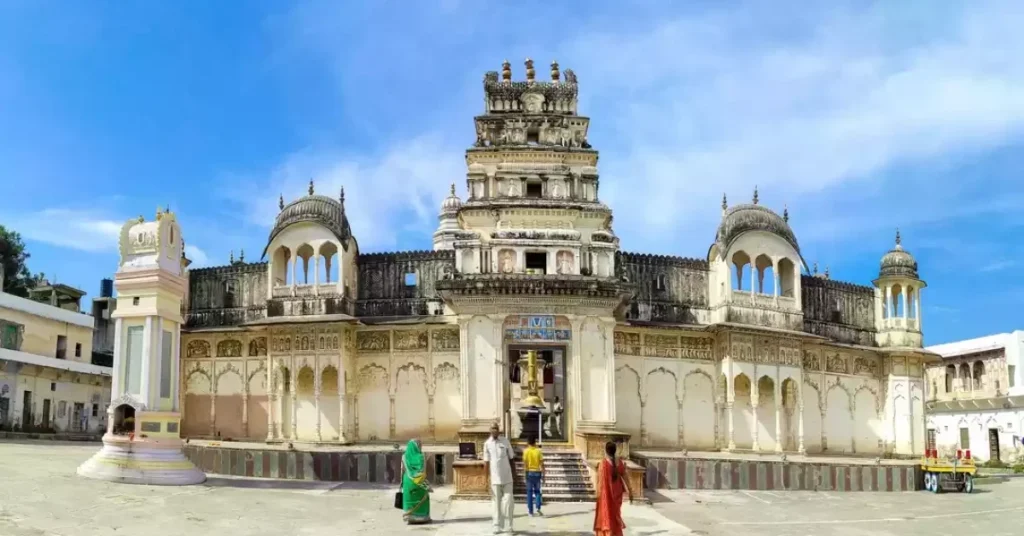
The Brahma Mandir Pushkar is not only a revered spiritual site but also a fine example of ancient temple architecture rooted in legend and symbolism. Its structure reflects centuries of devotion, mythological significance, and skilled craftsmanship.
🏛️ Construction Era, Legends & Renovation History
- The current structure of the Brahma Temple Pushkar is believed to have been originally built in the 14th century by the sage Adi Shankaracharya.
- However, many legends suggest that the site has been considered sacred for over 2000 years, with earlier versions of the temple possibly dating back to ancient times.
- Throughout history, the temple faced invasions and natural deterioration but was renovated and restored by Raja Jawat Raj of Ratlam in the 18th century.
- Despite these reconstructions, the sanctity and mythological importance of the site have remained unshaken.
🧱 Distinctive Features of Brahma Mandir Pushkar Architecture
- The temple is constructed primarily using marble and stone slabs, reflecting traditional Rajasthani craftsmanship.
- Its shikhara (spire) is painted a striking red, a color symbolizing creation and purity.
- The temple’s entrance features a hamsa (swan) motif, the vahana (vehicle) of Lord Brahma, carved in stone.
- Inside the sanctum, the idol of Lord Brahma is depicted with four faces, each looking in a different direction, symbolizing his omnipresence and universal vision.
🌀 Symbolism of the Temple Design
The architecture and elements of the brahma mandir pushkar carry deep spiritual meaning:
- The four-headed idol represents the four Vedas (Rigveda, Yajurveda, Samaveda, and Atharvaveda), underlining Brahma’s role as the knowledge-giver.
- The silver coins embedded in the floor symbolize offerings made by devotees through centuries.
- The marble flooring, worn by thousands of pilgrims, speaks to the temple’s enduring importance.
- The central sanctum is elevated, accessed by steps, symbolizing the journey from the material to the spiritual realm.
In every pillar, carving, and step, the Brahma Temple Pushkar preserves a slice of India’s sacred architectural legacy—where myth, devotion, and artistry come together in timeless harmony.
Brahma Temple Pushkar Timings and Best Time to Visit
Planning your visit to the Brahma Temple Pushkar requires understanding both its daily schedule and the seasonal factors that influence the spiritual and travel experience. Whether you’re a pilgrim or a tourist, the temple offers a peaceful setting for reflection and devotion throughout the year.
🕰️ Daily Opening and Closing Schedule
The Brahma Temple Pushkar timings follow a consistent daily routine, allowing visitors ample time to explore and offer prayers:
- Morning Darshan: 6:00 AM – 1:30 PM
- Evening Darshan: 3:00 PM – 9:00 PM
- The temple remains closed from 1:30 PM to 3:00 PM for mid-day rituals and cleaning.
- Visitors are advised to arrive early during weekends or festival days to avoid long queues.
These pushkar temple timings ensure that devotees can participate in the Aarti and other rituals both at dawn and dusk, the most spiritually energizing times of the day.
☀️ Seasonal Recommendations for Pilgrims and Tourists
The best time to visit Pushkar Mandir aligns with favorable weather conditions and festival calendars:
- October to March: Ideal for a visit, as the weather is cool and pleasant. This period includes key religious events and the famous Pushkar Camel Fair.
- April to June: Hot and dry; suitable only for early morning visits.
- July to September (Monsoon): Quieter with fewer crowds; the town becomes more scenic, but travel may be affected by rain.
This seasonal planning helps both pilgrims and tourists make the most of their visit, avoiding discomfort and maximizing their spiritual experience.
🪔 Special Days and Festivals: Kartik Purnima
One of the most significant times to visit is during Kartik Purnima, a full moon day in October or November:
- It is believed that Lord Brahma performed the yajna on this day, making it spiritually powerful.
- Thousands of pilgrims take a holy dip in Pushkar Lake and offer prayers at the Pushkar Ji Temple.
- The temple hosts special Aarti ceremonies, chants, and festive decorations, creating a deeply devotional atmosphere.
- This festival also coincides with the globally renowned Pushkar Camel Fair, adding a vibrant cultural dimension to your visit.
Whether you’re drawn by devotion or cultural exploration, understanding the brahma temple pushkar timings and planning your trip around key seasons and festivals ensures a fulfilling journey to this sacred destination.
Brahma Temple Pushkar Aarti Timings & Ritual Practices

One of the most spiritually moving experiences at the Brahma Temple Pushkar is attending the daily Aarti. These rituals, performed with chants, bells, and fire offerings, create a deeply devotional ambiance that leaves a lasting impression on visitors.
🔔 Daily Rituals and Aarti Details
The Brahma Temple Pushkar Aarti timings follow a fixed schedule and are observed with great reverence:
- Morning Aarti: Around 6:30 AM, coinciding with sunrise
- Evening Aarti: Around 7:00 PM, just after sunset
- Special Aartis are also performed during full moon days, particularly on Kartik Purnima
The temple priests lead these ceremonies, lighting lamps, offering incense, and reciting ancient Vedic mantras. The sight of the deity illuminated by the flickering flames, accompanied by the rhythmic sound of bells, creates a transcendental moment.
🪔 Importance of Aarti in Hindu Worship
In Hindu tradition, Aarti is a sacred offering of light to deities, symbolizing the removal of darkness (ignorance) and the invitation of divine blessings:
- It acts as a bridge between the devotee and the divine, filled with gratitude and reverence.
- Aarti is also a communal expression of faith, often accompanied by singing and collective prayer.
At Brahma Mandir Pushkar, this act becomes even more significant, given the temple’s rare status and spiritual lineage.
🙏 How to Participate as a Visitor or Devotee
Whether you’re a pilgrim or a curious traveler, you are welcome to participate in the Aarti rituals:
- Arrive 15–20 minutes early to secure a good spot inside the temple hall.
- Dress modestly and follow the guidance of temple staff.
- Offer flowers, ghee lamps, or donations as a gesture of devotion (optional).
- Photography is usually restricted during Aarti, so it’s best to be present fully in the moment.
Witnessing the brahma temple pushkar aarti timings unfold amid a sea of chanting and prayer is one of the most soul-stirring experiences in Pushkar.
Nearby Attractions and Other Temples in Pushkar
Beyond the Brahma Temple, Pushkar is home to several spiritual landmarks that enrich your journey through this sacred town. Exploring these sites offers a deeper understanding of the region’s religious and cultural heritage.
🛕 Other Important Temples in Pushkar
Several Pushkar Mandir enrich the spiritual landscape:
- Savitri Temple: Perched on a hilltop, this temple is dedicated to Brahma’s first wife, Goddess Savitri. A cable car or steep trek rewards you with panoramic views of Pushkar.
- Varaha Temple: One of the oldest temples in the city, devoted to Lord Vishnu’s boar incarnation, with intricately carved architecture.
- Rangji Temple: A rare blend of South Indian and Rajasthani architectural styles, dedicated to Lord Rangnath (a form of Vishnu).
- Gayatri Temple: Honoring Brahma’s second consort, built to balance the temple complex spiritually.
Each of these Pushkar Ji Temple sites adds a unique dimension to the pilgrimage experience.
🌊 Lake Pushkar and Its Sacred Ghats
- The holy Pushkar Lake is believed to have been formed from a lotus dropped by Lord Brahma.
- Surrounding the lake are 52 bathing ghats and over 300 temples, where rituals, holy dips, and evening prayers take place.
- Notable ghats include Varaha Ghat, Brahma Ghat, and Gau Ghat, each associated with distinct religious stories.
Taking a spiritual walk around the lake at sunrise or sunset allows for a meditative experience that connects visitors to the sacred geography of the town.
🧳 Local Experiences for Spiritual and Cultural Enrichment
- Participate in yoga sessions or spiritual discourses held near the ghats.
- Explore vibrant bazaars filled with spiritual souvenirs, books, and handmade goods.
- Attend the Pushkar Camel Fair (October–November), which brings together traders, artists, and pilgrims in a spectacular fusion of tradition and festivity.
🌐 Extend Your Journey Beyond Pushkar
For those inspired by Pushkar’s spiritual atmosphere, it’s worth expanding your travels to other culturally rich destinations. Many international visitors explore Pushkar as part of a broader circuit like the Golden Triangle Tour, which includes Delhi, Agra, and Jaipur.
If you’re a wildlife enthusiast, consider combining heritage with nature through the Golden Triangle Tour With Ranthambore, which includes a thrilling safari experience in Rajasthan’s famous tiger reserve.
For a deeply spiritual and soulful experience, the Golden Triangle Tour with Varanasi adds India’s most sacred city to your itinerary—offering evening Ganga Aarti, boat rides, and centuries-old temples along the holy river.
These journeys complement the essence of Pushkar, allowing travelers to immerse themselves in India’s layered spiritual, cultural, and historical dimensions.
Travel Tips for Visiting Brahma Temple Pushkar
A visit to the Brahma Temple Pushkar is not only a spiritual journey but also an opportunity to immerse yourself in the sacred culture of one of India’s holiest towns. To ensure a smooth and respectful experience, here are some essential travel tips every visitor should keep in mind.
👗 Dress Code and Respectful Behavior
- Wear modest, traditional clothing. Men should opt for full-length pants and shirts, while women are advised to wear sarees, salwar kameez, or long skirts with dupattas.
- Avoid revealing outfits and sleeveless tops, as this is a place of worship.
- Remove footwear before entering the temple premises. Shoe stands are provided near the entrance.
- Speak softly and maintain silence in the sanctum area to respect the spiritual atmosphere.
- Photography is strictly prohibited inside the temple sanctum.
Respect for local customs is not just appreciated—it’s expected, especially in a town as spiritually significant as Pushkar.
✅ Dos and Don’ts for Temple Visits
Dos:
- Do wash your hands and feet before entering.
- Do bring an offering like flowers, coconuts, or sweets (available at nearby shops).
- Do participate in Aarti if you arrive at the right time.
- Do respect the queue and follow priest instructions.
Don’ts:
- Don’t touch idols or enter restricted areas.
- Don’t carry leather items (belts, wallets) into the temple.
- Don’t use mobile phones inside.
- Don’t offer money directly to priests—use donation boxes if you wish to contribute.
Following these practices ensures you remain aligned with temple decorum and local beliefs.
🍛 Nearby Facilities (Food, Shops, Guides)
- Food Options: Pushkar offers a wide range of vegetarian eateries and rooftop cafes near the temple. Popular choices include street food stalls serving kachoris, malpua, and chai.
- Shops: Numerous shops near the Pushkar Ji Temple sell spiritual items like rudraksha beads, brass idols, incense sticks, and souvenirs.
- Guides: Local government-approved tourist guides are available and can offer rich insights into the temple’s mythology and rituals. Hiring a guide is especially helpful during festivals or if you’re visiting as part of a cultural tour.
Pushkar, being a prominent destination for both Indian and foreign tourists, is well-equipped to cater to travelers of all backgrounds. A little preparation and cultural awareness will enhance your experience, making your visit to the Brahma Mandir Pushkar truly memorable.

